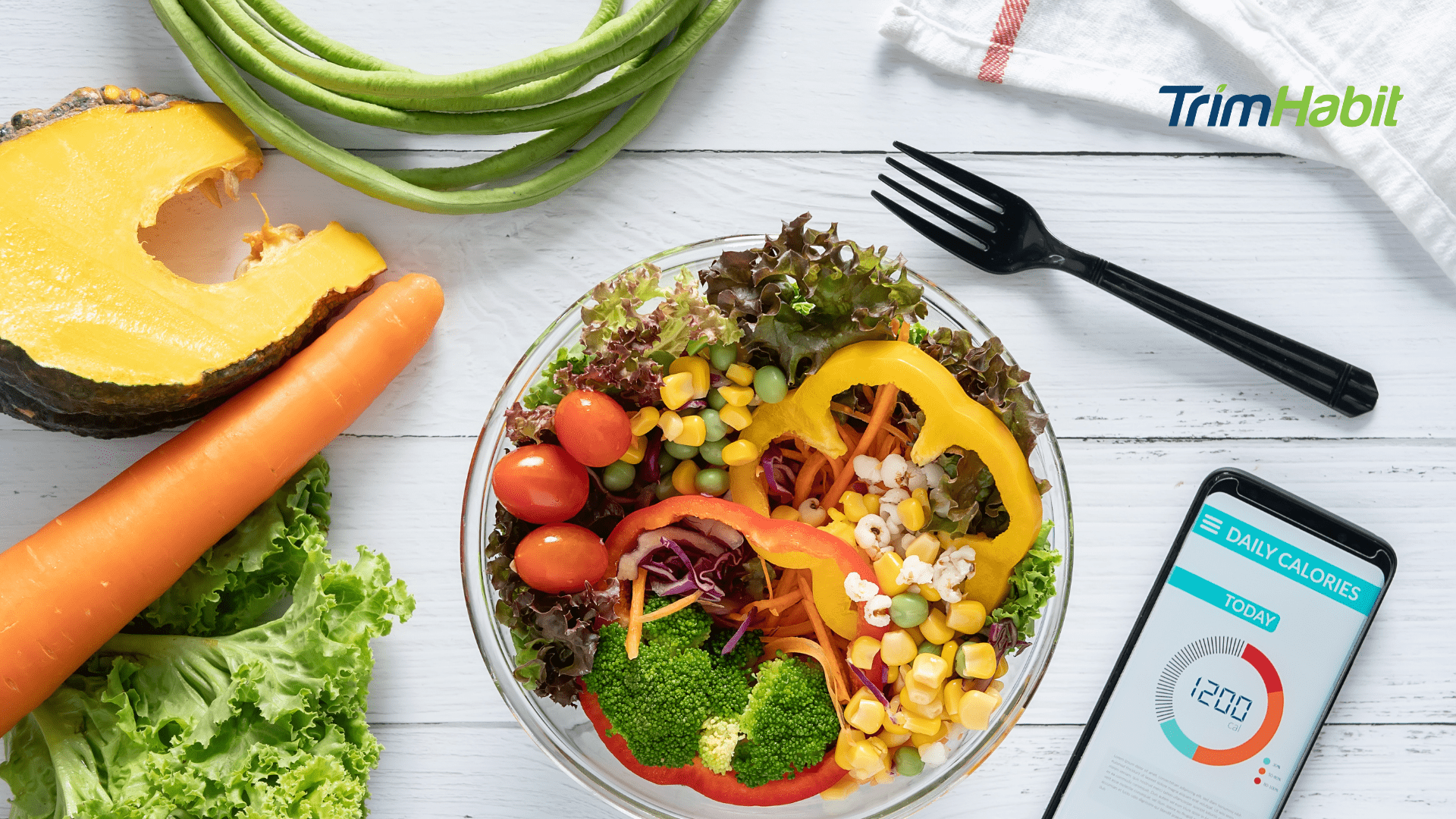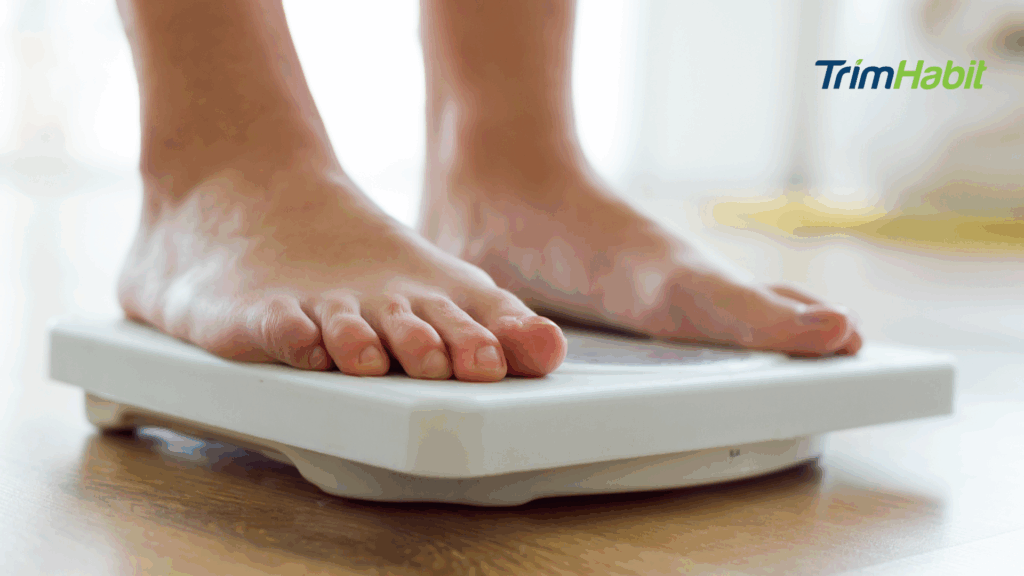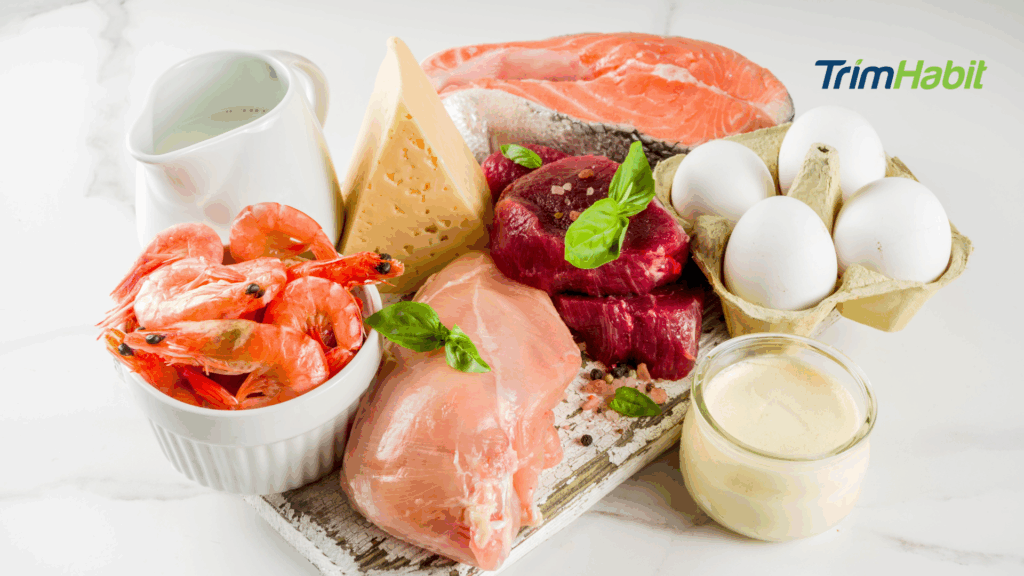Semaglutide has quickly become a game-changer in the world of weight management, offering real, measurable results for those struggling to lose weight. However, medication alone isn’t the complete solution. To achieve the best outcomes with semaglutide, pairing it with mindful eating habits is essential, often meaning adopting a low-calorie, nutrient-dense meal plan.
In this article, we’ll guide you through a low calorie meal plan for semaglutide weight loss. Whether you’re just starting on semaglutide or looking to fine-tune your current eating routine on your weight loss journey, this guide will provide practical tips, sample meals, and key nutrition strategies to help you succeed.
How Semaglutide Works
Semaglutide is a medication used primarily for type 2 diabetes and weight management. It belongs to a class of drugs called GLP-1 receptor agonists (glucagon-like peptide-1)1.
Mechanism of Action
Semaglutide mimics the action of a naturally occurring hormone called GLP-1, which is released in the gut after eating2. It affects the body in several key ways:
Stimulates Insulin Secretion
- When blood sugar levels are high, semaglutide prompts the pancreas to release more insulin3.
- Insulin helps move sugar from the blood into the cells, lowering blood glucose levels3.
Suppresses Glucagon Release
- Glucagon is a hormone that raises blood sugar by prompting the liver to release stored glucose4.
- Semaglutide reduces glucagon levels when blood sugar is high, helping prevent further increases in blood glucose4.
Slows Gastric Emptying
- It delays food movement from the stomach to the small intestine.
- This slows the rate of glucose absorption, resulting in more stable blood sugar levels and increased satiety (feeling full)5.
Reduces Appetite and Promotes Weight Loss
- Semaglutide acts on brain regions involved in appetite regulation6.
- It helps people feel fuller sooner and for longer, which can lead to reduced calorie intake and weight loss6.
Uses
- Type 2 Diabetes: Improves blood sugar control.
- Obesity/Overweight Management: Helps with weight loss even in people without diabetes.
Key Principles Of A Low-Calorie Meal Plan For Semaglutide
Prioritize Nutrient-Dense, Low-Calorie Foods
Choose foods rich in vitamins, minerals, and fiber but low in calories.
- Non-starchy vegetables: leafy greens, broccoli, zucchini, peppers, cauliflower
- Lean proteins: chicken breast, turkey, tofu, egg whites, fish
- Low-sugar fruits: berries, kiwi, apples (in moderation)
Include Lean Protein at Every Meal
Protein supports satiety and helps preserve muscle mass during weight loss.
- Aim for 15–30 grams of protein per meal.
- Sources: eggs, fish, chicken, Greek yogurt, legumes
Limit Added Sugars and Refined Carbs
Semaglutide improves insulin sensitivity, so avoiding foods that cause rapid glucose spikes is essential.
- Avoid: white bread, pastries, sweetened drinks, candy
- Choose: whole grains like quinoa, oats, and brown rice (in moderate amounts)
Control Portions and Caloric Intake
Semaglutide reduces appetite, making portion control more manageable.
- Use smaller plates
- Be mindful of hunger/fullness cues
- Most plans aim for 1,200–1,800 calories per day, depending on individual needs
Focus on Healthy Fats
Include small amounts of unsaturated fats to aid satiety and nutrient absorption.
- Sources: olive oil, avocado, nuts, seeds, fatty fish
- Limit saturated fats and avoid trans fats
Stay Hydrated
Adequate hydration supports metabolism and can help reduce feelings of hunger, supporting healthy digestive function.
- Aim for at least 8 cups (2 liters) of water daily
- Limit sugary drinks and excessive caffeine
Eat Smaller, Balanced Meals
Smaller, frequent meals can improve digestion and match Semaglutide’s delayed gastric emptying.
- Example: 3 meals and 1–2 small snacks
- Balance each meal with protein, fiber, and healthy fat
Minimize Ultra-Processed Foods
These are often high in calories, low in nutrients, and can counteract the benefits of the medication.
- Limit frozen meals, fast food, packaged snacks, and sugary cereals
Be Mindful of Gastrointestinal Side Effects
Semaglutide may cause nausea or bloating, especially early in treatment. To reduce discomfort:
- Eat slowly
- Avoid greasy or overly rich foods
- Stop eating before feeling too full
Customize for Individual Needs
Each person’s plan should reflect their:
- Caloric needs (based on weight, activity, and goals)
- Medical conditions (e.g., diabetes, hypertension)
- Food preferences and tolerances
Low Calorie Meal Plan For Semaglutide Weight Loss
Here are multiple sample options for each meal to keep your low-calorie Semaglutide weight loss plan flexible, satisfying, and easy to follow. Each option is designed to be approximately 350–450 calories per meal and 150–200 calories for snacks, while supporting appetite control and stable blood sugar.
Breakfast Options (~350–400 Calories)
1. Veggie Omelet + Berries
- 2 eggs + 2 egg whites
- Spinach, mushrooms, onions
- ½ cup blueberries
- 1 tsp olive oil
2. Greek Yogurt Parfait
- ¾ cup plain Greek yogurt (2%)
- ¼ cup granola (low sugar)
- ½ banana, sliced
- Sprinkle of chia seeds
3. Protein Oatmeal
- ½ cup oats + water or unsweetened almond milk
- 1 scoop protein powder (vanilla or plain)
- 1 tbsp almond butter
- Cinnamon + ¼ apple diced
4. Avocado Toast with Egg
- 1 slice whole-grain toast
- ½ avocado mashed
- 1 poached or boiled egg
- ½ grapefruit on the side
Lunch Options (~400 Calories)
1. Grilled Chicken Salad
- 3-4 oz grilled chicken
- Mixed greens, tomato, cucumber
- ¼ avocado
- 1 tbsp olive oil + lemon dressing
2. Turkey Wrap
- 1 whole-wheat low-carb wrap
- 3 oz lean turkey
- Lettuce, mustard, tomato
- 1 string cheese or one small apple
3. Quinoa Bowl
- ½ cup cooked quinoa
- ½ cup roasted chickpeas or 3 oz tofu
- Roasted veggies (zucchini, bell pepper, onion)
- Drizzle of tahini or olive oil
4. Tuna Salad Plate
- 1 can of tuna (in water), mixed with mustard/yogurt
- Served on a bed of greens with sliced tomato and cucumber
- 5–6 whole grain crackers or ½ slice of bread
Snack Options (~150–200 Calories)
1. Greek Yogurt + Almonds
- ¾ cup Greek yogurt
- 1 tbsp slivered almonds or chia seeds
2. Apple with Nut Butter
- 1 small apple
- 1 tbsp almond or peanut butter
3. Hard-Boiled Eggs & Carrots
- 1 hard-boiled egg
- ½ cup baby carrots or cucumber slices
4. Cottage Cheese & Berries
- ½ cup low-fat cottage cheese
- ¼ cup blueberries or strawberries
5. Protein Shake (Mini)
- 1 scoop protein powder
- Water or unsweetened almond milk
- Optional: ¼ banana or cinnamon
Dinner Options (~400–450 Calories)
1. Baked Salmon + Roasted Veggies
- 4 oz salmon
- 1 cup roasted broccoli and carrots
- ½ cup quinoa or cauliflower rice
2. Turkey Zucchini Skillet
- 4 oz ground turkey
- Zucchini, mushrooms, and onions sautéed in 1 tsp olive oil
- ½ cup brown rice
3. Stir-Fry with Shrimp
- 4 oz shrimp sautéed in garlic and low-sodium soy sauce
- Mixed vegetables (bell peppers, snap peas)
- ½ cup cooked rice or riced cauliflower
4. Lentil & Spinach Soup
- 1½ cups homemade lentil soup (with tomatoes, celery, spinach)
- 1 slice whole grain toast or 5–6 crackers
- Optional: Sprinkle of Parmesan or squeeze of lemon
Tips For Meal Planning And Preparation
Plan Around Protein First
- Start each meal with a lean protein source (chicken, fish, eggs, tofu, legumes).
- Protein keeps you fuller longer and helps preserve lean muscle during weight loss.
Build Balanced Plates
Follow the “½-¼-¼” rule:
- ½ plate: non-starchy vegetables
- ¼ plate: lean protein
- ¼ plate: healthy carbs (whole grains, legumes, sweet potato)
Repeat and Rotate Core Meals
- Choose 2–3 go-to options for breakfast, lunch, and dinner per week.
- Rotate ingredients (e.g., salmon one night, tofu the next) to prevent boredom while keeping prep easy.
Choose Versatile Ingredients
- Use staples that can be repurposed:
- Grilled chicken → wraps, salads, bowls
- Cooked quinoa → side dish, breakfast base, salad topping
- Roasted veggies → sides, stir-fries, omelets
Make a Weekly Plan and Grocery List
- Plan 5-7 days of meals and snacks ahead of time.
- Write a grocery list organized by category (produce, protein, pantry) to shop efficiently.
Prep in Batches
- Cook proteins (grilled chicken, baked tofu, hard-boiled eggs) in bulk.
- Roast a big tray of veggies at once.
- Pre-portion cooked grains (quinoa, brown rice) into containers.
Portion for Easy Grab-and-Go
- Use containers to portion out meals/snacks in advance.
- Label by day or meal if needed.
- Store snacks like carrots, nuts, or yogurt in individual servings.
Use Time-Saving Appliances
- Air fryer: great for quick proteins and veggies with little oil
- Instant Pot or slow cooker: ideal for soups, stews, and batch cooking
- Blender: for shakes and smoothies on the go
Don’t Overcomplicate
- Simple meals with 3-5 whole-food ingredients often taste great and are easy to digest on Semaglutide.
- Stick with easy recipes while adjusting to the medication, especially if you’re managing nausea.
Common Mistakes To Avoid
Skipping Meals or Undereating
- Why it’s a mistake: Semaglutide naturally suppresses appetite, but skipping meals can lead to overeating later in the day or cause blood sugar imbalances.
- What to do instead: Eat three balanced meals and 1-2 snacks daily. Keep meals smaller but frequent to maintain stable energy levels and prevent overeating.
Overrelying on Processed Low-Calorie Foods
- Why it’s a mistake: Some processed low-calorie foods (e.g., diet bars, fat-free snacks) may contain artificial sweeteners, unhealthy fats, and added sugar that can cause blood sugar fluctuations.
- What to do instead: Focus on whole, nutrient-dense foods that provide fiber, vitamins, and minerals.
Ignoring Portion Control
- Why it’s a mistake: Even healthy foods can lead to weight gain if portion sizes are too large. Semaglutide reduces appetite, making it easy to underestimate how much you’re eating.
- What to do instead: Be mindful of portion sizes. Use smaller plates or pre-portion meals to keep calories in check. Consider using a food scale for accurate measurements when first getting started.
Not Tracking Progress
- Why it’s a mistake: Without tracking meals, progress, and side effects, it’s hard to know what’s working and what’s not.
- What to do instead: Keep a food journal or use an app to track meals, calories, and changes in weight, energy, or digestion. Track hunger cues and fullness levels throughout the day.
Consuming Too Many Liquids with Calories
- Why it’s a mistake: Calories from sugary beverages (sodas, fruit juices, smoothies) can easily add up without providing lasting satiety, especially when you’re on Semaglutide, which already reduces appetite.
- What to do instead: Stick to water, herbal tea, or black coffee. If you drink smoothies, ensure they’re balanced with protein and fiber and avoid adding too much sugar or juice.
Ignoring Fiber Intake
- Why it’s a mistake: Low-fiber meals may not support digestion or fullness, leading to hunger and overeating later.
- What to do instead: Incorporate fiber-rich foods like vegetables, legumes, whole grains, and fruits. Fiber helps improve digestion and stabilizes blood sugar.
Avoiding All Carbs
- Why it’s a mistake: Eliminating carbohydrates entirely can lead to nutrient deficiencies and an imbalance in energy levels. Healthy carbs (like whole grains) are essential for long-term weight loss and well-being.
- What to do instead: Include moderate portions of complex carbohydrates like quinoa, oats, brown rice, or sweet potatoes, which are fiber-rich and have a lower glycemic index.
Failing to Adapt to Semaglutide Side Effects
- Why it’s a mistake: Nausea, bloating, or gastrointestinal discomfort are common early side effects of Semaglutide, and ignoring them can lead to frustration or poor dietary choices.
- What to do instead: If you experience nausea or discomfort, consider lowering your dose with your provider’s guidance, eating smaller bland meals, adding light activity, and tracking your symptoms to find what helps.
Not Listening to Hunger and Fullness Cues
- Why it’s a mistake: Semaglutide suppresses appetite, but it’s still essential to eat when hungry and stop when you’re full. Relying solely on the medication’s effects can cause you to miss key hunger signals or ignore the need for balanced nutrition.
- What to do instead: Tune in to your body’s signals. Even though your appetite might be suppressed, ensure you’re eating enough to fuel your body, especially when you’re active.
Getting Discouraged by Slow Progress
- Why it’s a mistake: Weight loss can be gradual, and results may take time, especially when on medications like Semaglutide. If you expect immediate or dramatic changes, you might feel frustrated.
- What to do instead: Stay patient and focus on long-term health rather than quick fixes. Celebrate small wins (e.g., improved energy, more stable blood sugar) and adjust your plan as needed.









